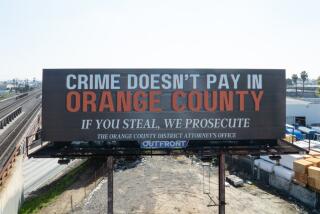State Unveils TV Ads Against Cigars
SACRAMENTO — State health officials, alarmed by increased cigar smoking among youths and young adults, announced a new advertising campaign Monday aimed at combating the fad and built around the theme, “Cigars, the big new trend in cancer.”
Shortly after the Department of Health Services previewed the anti-cigar campaign, state senators, reviewing the department’s 1998-1999 budget proposal, lambasted health officials for delays in the release of new anti-tobacco ads.
Kimberly Belshe, the head of the Department of Health Services, defended the department’s process, saying that development of sharp-edged ads takes time. She said that although the department had hoped to have a full package of new ads on the air this month, they won’t be complete until late May or early June.
“We are still in the process of developing the creative,” Belshe said. Belshe added that the new television, radio and billboard ads will be hard-hitting and set an “example for the rest of the nation.”
For the time being, the department plans to begin airing one cigar ad on television and another on radio starting today. The spots are part of a $22-million annual campaign funded by a 25-cent-per-pack tax on cigarettes, imposed when voters approved Proposition 99 in 1988.
The one television ad released Monday focuses on the health effects of cigar use and features a man dressed in a business suit being handed a cigar. As the man, “Chad,” fondles the cigar, a narrator says: “Big cigar you got there, Chad.”
“And expensive too,” the man says.
“Say, Chad, any idea how many cigarettes you’d need to equal the nicotine in that big fat stogie?”
“Uh, three, maybe?” he says as three cigarettes appear in “Chad’s” mouth.
“Nope.”
“Seven?”
“Guess again.”
“Twenty?”
“No, Chad, you’d have to smoke more than 70.”
Seventy cigarettes appear in his mouth. The narrator says, “Need a light, Chad?”
Along with the new ads, the department released results of a survey showing that cigar use has grown rapidly in recent years, especially among children and young adults. The report shows that the number of California men ages 18 to 24 who smoke cigars increased threefold, from 4% in 1990 to 13% in 1996.
“The cigar fad is not an accident,” said Sandra Smoley, Gov. Pete Wilson’s secretary of the health and welfare agency. “It is a carefully orchestrated plan by public relations firms, celebrity endorsements, product placement on television and in movies.”
At Monday’s news conference, authorities said cigar smoke can be even more toxic than smoke from cigarettes. Dr. David M. Burns, a medical professor at UC San Diego, noted that cigar smoke contains more carbon monoxide and ammonia than cigarette smoke.
In an interview, Stanton Glantz, a member of a state committee established to oversee the department’s anti-tobacco advertising campaign, praised the department for “beginning to deal with the cigar problem.”
But Glantz cited a recent research paper he co-wrote showing that ads focusing on the health effects of smoking are less effective than those using other tactics. Among the more effective approaches is to attack the tobacco industry and show how it manipulates the public. Another technique is to attempt to make smoking seem less glamorous.
Glantz cited a tax-funded ad campaign run in San Francisco in 1996 that used the theme: “Cigars, they look like what they smell like.”
California’s ad campaign has been attacked repeatedly in recent years by anti-smoking advocates who charge that the department has delayed releasing new rounds of ads, and has softened what ends up on the air.
The attack reached a state Senate budget subcommittee Monday, when Sen. Mike Thompson (D-St. Helena) demanded that the department accelerate the release of new anti-tobacco ads.
“This is review after review after review,” Thompson said, referring to a schedule showing the department’s process for approving new ads. Referring to a department memo detailing the time it takes to approve a new ad, Thompson, sounding incredulous, said: “Eight months? Eight months?
“There is nobody in the world who goes through this lengthy of a process [to get an ad on the air],” Thompson added. “If the auto companies did this, the new models already would be on the market. This is ridiculous.”
More to Read
Sign up for Essential California
The most important California stories and recommendations in your inbox every morning.
You may occasionally receive promotional content from the Los Angeles Times.










